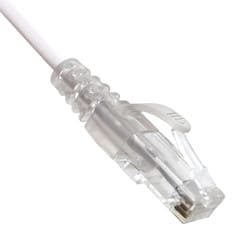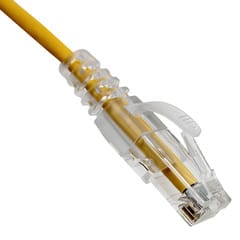-
 This 25-foot Category 8.1 cable, Class I channel, features an orange PVC jacket, braided outer shield, with four individually mylar foil shielded 24 AWG pure copper pairs as defined in ISO/IEC 11801 and ratified in ANSI/TIA 568-C.2-1. Cat8 cabling was designed primarily for high-speed data centers where switches, servers, and other network hardware are located in close proximity. This newest copper communications cable offers greater flexibility both literally and in distances when compared to QSFP+ and Twinax DAC assemblies which typically cost significantly more and are often much more limited in scope. It has the reach to cover Top-of-Rack and End-of-Row or Middle-of-Row network topologies while delivering 10, 25, and 40 Gigabit data rates over BASE-T technology with RJ45 ends making it a drop-in replacement for Cat6a where rates beyond 10Gb will be needed today or in the future. Cat8 has stricter specifications for noise restriction and crosstalk than any of its predecessors. The individual conductors are 24 AWG (American wire gauge) stranded pure copper. Cat8 patch cables are stranded to improve flexibility. Pure copper conductors provide the best signal possible. Each pair of conductors is shielded with an aluminum mylar foil to reduce, if not eliminate, crosstalk. These cables also have a braided shield, which protects from outside electromagnetic interference.Part No. 13X8-53125
This 25-foot Category 8.1 cable, Class I channel, features an orange PVC jacket, braided outer shield, with four individually mylar foil shielded 24 AWG pure copper pairs as defined in ISO/IEC 11801 and ratified in ANSI/TIA 568-C.2-1. Cat8 cabling was designed primarily for high-speed data centers where switches, servers, and other network hardware are located in close proximity. This newest copper communications cable offers greater flexibility both literally and in distances when compared to QSFP+ and Twinax DAC assemblies which typically cost significantly more and are often much more limited in scope. It has the reach to cover Top-of-Rack and End-of-Row or Middle-of-Row network topologies while delivering 10, 25, and 40 Gigabit data rates over BASE-T technology with RJ45 ends making it a drop-in replacement for Cat6a where rates beyond 10Gb will be needed today or in the future. Cat8 has stricter specifications for noise restriction and crosstalk than any of its predecessors. The individual conductors are 24 AWG (American wire gauge) stranded pure copper. Cat8 patch cables are stranded to improve flexibility. Pure copper conductors provide the best signal possible. Each pair of conductors is shielded with an aluminum mylar foil to reduce, if not eliminate, crosstalk. These cables also have a braided shield, which protects from outside electromagnetic interference.Part No. 13X8-53125 -
 This 10-foot Category 8.1 cable, Class I channel, features an orange PVC jacket, braided outer shield, with four individually mylar foil shielded 24 AWG pure copper pairs as defined in ISO/IEC 11801 and ratified in ANSI/TIA 568-C.2-1. Cat8 cabling was designed primarily for high-speed data centers where switches, servers, and other network hardware are located in close proximity. This newest copper communications cable offers greater flexibility both literally and in distances when compared to QSFP+ and Twinax DAC assemblies which typically cost significantly more and are often much more limited in scope. It has the reach to cover Top-of-Rack and End-of-Row or Middle-of-Row network topologies while delivering 10, 25, and 40 Gigabit data rates over BASE-T technology with RJ45 ends making it a drop-in replacement for Cat6a where rates beyond 10Gb will be needed today or in the future. Cat8 has stricter specifications for noise restriction and crosstalk than any of its predecessors. The individual conductors are 24 AWG (American wire gauge) stranded pure copper. Cat8 patch cables are stranded to improve flexibility. Pure copper conductors provide the best signal possible. Each pair of conductors is shielded with an aluminum mylar foil to reduce, if not eliminate, crosstalk. These cables also have a braided shield, which protects from outside electromagnetic interference.Part No. 13X8-53110
This 10-foot Category 8.1 cable, Class I channel, features an orange PVC jacket, braided outer shield, with four individually mylar foil shielded 24 AWG pure copper pairs as defined in ISO/IEC 11801 and ratified in ANSI/TIA 568-C.2-1. Cat8 cabling was designed primarily for high-speed data centers where switches, servers, and other network hardware are located in close proximity. This newest copper communications cable offers greater flexibility both literally and in distances when compared to QSFP+ and Twinax DAC assemblies which typically cost significantly more and are often much more limited in scope. It has the reach to cover Top-of-Rack and End-of-Row or Middle-of-Row network topologies while delivering 10, 25, and 40 Gigabit data rates over BASE-T technology with RJ45 ends making it a drop-in replacement for Cat6a where rates beyond 10Gb will be needed today or in the future. Cat8 has stricter specifications for noise restriction and crosstalk than any of its predecessors. The individual conductors are 24 AWG (American wire gauge) stranded pure copper. Cat8 patch cables are stranded to improve flexibility. Pure copper conductors provide the best signal possible. Each pair of conductors is shielded with an aluminum mylar foil to reduce, if not eliminate, crosstalk. These cables also have a braided shield, which protects from outside electromagnetic interference.Part No. 13X8-53110 -
 This 5-foot Category 8.1 cable, Class I channel, features an orange PVC jacket, braided outer shield, with four individually mylar foil shielded 24 AWG pure copper pairs as defined in ISO/IEC 11801 and ratified in ANSI/TIA 568-C.2-1. Cat8 cabling was designed primarily for high-speed data centers where switches, servers, and other network hardware are located in close proximity. This newest copper communications cable offers greater flexibility both literally and in distances when compared to QSFP+ and Twinax DAC assemblies which typically cost significantly more and are often much more limited in scope. It has the reach to cover Top-of-Rack and End-of-Row or Middle-of-Row network topologies while delivering 10, 25, and 40 Gigabit data rates over BASE-T technology with RJ45 ends making it a drop-in replacement for Cat6a where rates beyond 10Gb will be needed today or in the future. Cat8 has stricter specifications for noise restriction and crosstalk than any of its predecessors. The individual conductors are 24 AWG (American wire gauge) stranded pure copper. Cat8 patch cables are stranded to improve flexibility. Pure copper conductors provide the best signal possible. Each pair of conductors is shielded with an aluminum mylar foil to reduce, if not eliminate, crosstalk. These cables also have a braided shield, which protects from outside electromagnetic interference.Part No. 13X8-53105
This 5-foot Category 8.1 cable, Class I channel, features an orange PVC jacket, braided outer shield, with four individually mylar foil shielded 24 AWG pure copper pairs as defined in ISO/IEC 11801 and ratified in ANSI/TIA 568-C.2-1. Cat8 cabling was designed primarily for high-speed data centers where switches, servers, and other network hardware are located in close proximity. This newest copper communications cable offers greater flexibility both literally and in distances when compared to QSFP+ and Twinax DAC assemblies which typically cost significantly more and are often much more limited in scope. It has the reach to cover Top-of-Rack and End-of-Row or Middle-of-Row network topologies while delivering 10, 25, and 40 Gigabit data rates over BASE-T technology with RJ45 ends making it a drop-in replacement for Cat6a where rates beyond 10Gb will be needed today or in the future. Cat8 has stricter specifications for noise restriction and crosstalk than any of its predecessors. The individual conductors are 24 AWG (American wire gauge) stranded pure copper. Cat8 patch cables are stranded to improve flexibility. Pure copper conductors provide the best signal possible. Each pair of conductors is shielded with an aluminum mylar foil to reduce, if not eliminate, crosstalk. These cables also have a braided shield, which protects from outside electromagnetic interference.Part No. 13X8-53105 -
 This 3-foot Category 8.1 cable, Class I channel, features an orange PVC jacket, braided outer shield, with four individually mylar foil shielded 24 AWG pure copper pairs as defined in ISO/IEC 11801 and ratified in ANSI/TIA 568-C.2-1. Cat8 cabling was designed primarily for high-speed data centers where switches, servers, and other network hardware are located in close proximity. This newest copper communications cable offers greater flexibility both literally and in distances when compared to QSFP+ and Twinax DAC assemblies which typically cost significantly more and are often much more limited in scope. It has the reach to cover Top-of-Rack and End-of-Row or Middle-of-Row network topologies while delivering 10, 25, and 40 Gigabit data rates over BASE-T technology with RJ45 ends making it a drop-in replacement for Cat6a where rates beyond 10Gb will be needed today or in the future. Cat8 has stricter specifications for noise restriction and crosstalk than any of its predecessors. The individual conductors are 24 AWG (American wire gauge) stranded pure copper. Cat8 patch cables are stranded to improve flexibility. Pure copper conductors provide the best signal possible. Each pair of conductors is shielded with an aluminum mylar foil to reduce, if not eliminate, crosstalk. These cables also have a braided shield, which protects from outside electromagnetic interference.Part No. 13X8-53103
This 3-foot Category 8.1 cable, Class I channel, features an orange PVC jacket, braided outer shield, with four individually mylar foil shielded 24 AWG pure copper pairs as defined in ISO/IEC 11801 and ratified in ANSI/TIA 568-C.2-1. Cat8 cabling was designed primarily for high-speed data centers where switches, servers, and other network hardware are located in close proximity. This newest copper communications cable offers greater flexibility both literally and in distances when compared to QSFP+ and Twinax DAC assemblies which typically cost significantly more and are often much more limited in scope. It has the reach to cover Top-of-Rack and End-of-Row or Middle-of-Row network topologies while delivering 10, 25, and 40 Gigabit data rates over BASE-T technology with RJ45 ends making it a drop-in replacement for Cat6a where rates beyond 10Gb will be needed today or in the future. Cat8 has stricter specifications for noise restriction and crosstalk than any of its predecessors. The individual conductors are 24 AWG (American wire gauge) stranded pure copper. Cat8 patch cables are stranded to improve flexibility. Pure copper conductors provide the best signal possible. Each pair of conductors is shielded with an aluminum mylar foil to reduce, if not eliminate, crosstalk. These cables also have a braided shield, which protects from outside electromagnetic interference.Part No. 13X8-53103 -
 This 1-foot Category 8.1 cable, Class I channel, features an orange PVC jacket, braided outer shield, with four individually mylar foil shielded 24 AWG pure copper pairs as defined in ISO/IEC 11801 and ratified in ANSI/TIA 568-C.2-1. Cat8 cabling was designed primarily for high-speed data centers where switches, servers, and other network hardware are located in close proximity. This newest copper communications cable offers greater flexibility both literally and in distances when compared to QSFP+ and Twinax DAC assemblies which typically cost significantly more and are often much more limited in scope. It has the reach to cover Top-of-Rack and End-of-Row or Middle-of-Row network topologies while delivering 10, 25, and 40 Gigabit data rates over BASE-T technology with RJ45 ends making it a drop-in replacement for Cat6a where rates beyond 10Gb will be needed today or in the future. Cat8 has stricter specifications for noise restriction and crosstalk than any of its predecessors. The individual conductors are 24 AWG (American wire gauge) stranded pure copper. Cat8 patch cables are stranded to improve flexibility. Pure copper conductors provide the best signal possible. Each pair of conductors is shielded with an aluminum mylar foil to reduce, if not eliminate, crosstalk. These cables also have a braided shield, which protects from outside electromagnetic interference.Part No. 13X8-53101
This 1-foot Category 8.1 cable, Class I channel, features an orange PVC jacket, braided outer shield, with four individually mylar foil shielded 24 AWG pure copper pairs as defined in ISO/IEC 11801 and ratified in ANSI/TIA 568-C.2-1. Cat8 cabling was designed primarily for high-speed data centers where switches, servers, and other network hardware are located in close proximity. This newest copper communications cable offers greater flexibility both literally and in distances when compared to QSFP+ and Twinax DAC assemblies which typically cost significantly more and are often much more limited in scope. It has the reach to cover Top-of-Rack and End-of-Row or Middle-of-Row network topologies while delivering 10, 25, and 40 Gigabit data rates over BASE-T technology with RJ45 ends making it a drop-in replacement for Cat6a where rates beyond 10Gb will be needed today or in the future. Cat8 has stricter specifications for noise restriction and crosstalk than any of its predecessors. The individual conductors are 24 AWG (American wire gauge) stranded pure copper. Cat8 patch cables are stranded to improve flexibility. Pure copper conductors provide the best signal possible. Each pair of conductors is shielded with an aluminum mylar foil to reduce, if not eliminate, crosstalk. These cables also have a braided shield, which protects from outside electromagnetic interference.Part No. 13X8-53101 -
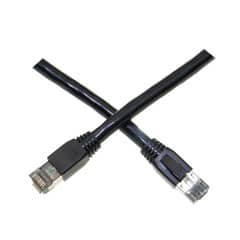 This 35-foot Category 8.1 cable, Class I channel, features a black PVC jacket, braided outer shield, with four individually mylar foil shielded 24 AWG pure copper pairs as defined in ISO/IEC 11801 and ratified in ANSI/TIA 568-C.2-1. Cat8 cabling was designed primarily for high-speed data centers where switches, servers, and other network hardware are located in close proximity. This newest copper communications cable offers greater flexibility both literally and in distances when compared to QSFP+ and Twinax DAC assemblies which typically cost significantly more and are often much more limited in scope. It has the reach to cover Top-of-Rack and End-of-Row or Middle-of-Row network topologies while delivering 10, 25, and 40 Gigabit data rates over BASE-T technology with RJ45 ends making it a drop-in replacement for Cat6a where rates beyond 10Gb will be needed today or in the future. Cat8 has stricter specifications for noise restriction and crosstalk than any of its predecessors. The individual conductors are 24 AWG (American wire gauge) stranded pure copper. Cat8 patch cables are stranded to improve flexibility. Pure copper conductors provide the best signal possible. Each pair of conductors is shielded with an aluminum mylar foil to reduce, if not eliminate, crosstalk. These cables also have a braided shield, which protects from outside electromagnetic interference.Part No. 13X8-52235
This 35-foot Category 8.1 cable, Class I channel, features a black PVC jacket, braided outer shield, with four individually mylar foil shielded 24 AWG pure copper pairs as defined in ISO/IEC 11801 and ratified in ANSI/TIA 568-C.2-1. Cat8 cabling was designed primarily for high-speed data centers where switches, servers, and other network hardware are located in close proximity. This newest copper communications cable offers greater flexibility both literally and in distances when compared to QSFP+ and Twinax DAC assemblies which typically cost significantly more and are often much more limited in scope. It has the reach to cover Top-of-Rack and End-of-Row or Middle-of-Row network topologies while delivering 10, 25, and 40 Gigabit data rates over BASE-T technology with RJ45 ends making it a drop-in replacement for Cat6a where rates beyond 10Gb will be needed today or in the future. Cat8 has stricter specifications for noise restriction and crosstalk than any of its predecessors. The individual conductors are 24 AWG (American wire gauge) stranded pure copper. Cat8 patch cables are stranded to improve flexibility. Pure copper conductors provide the best signal possible. Each pair of conductors is shielded with an aluminum mylar foil to reduce, if not eliminate, crosstalk. These cables also have a braided shield, which protects from outside electromagnetic interference.Part No. 13X8-52235 -
 This 25-foot Category 8.1 cable, Class I channel, features a black PVC jacket, braided outer shield, with four individually mylar foil shielded 24 AWG pure copper pairs as defined in ISO/IEC 11801 and ratified in ANSI/TIA 568-C.2-1. Cat8 cabling was designed primarily for high-speed data centers where switches, servers, and other network hardware are located in close proximity. This newest copper communications cable offers greater flexibility both literally and in distances when compared to QSFP+ and Twinax DAC assemblies which typically cost significantly more and are often much more limited in scope. It has the reach to cover Top-of-Rack and End-of-Row or Middle-of-Row network topologies while delivering 10, 25, and 40 Gigabit data rates over BASE-T technology with RJ45 ends making it a drop-in replacement for Cat6a where rates beyond 10Gb will be needed today or in the future. Cat8 has stricter specifications for noise restriction and crosstalk than any of its predecessors. The individual conductors are 24 AWG (American wire gauge) stranded pure copper. Cat8 patch cables are stranded to improve flexibility. Pure copper conductors provide the best signal possible. Each pair of conductors is shielded with an aluminum mylar foil to reduce, if not eliminate, crosstalk. These cables also have a braided shield, which protects from outside electromagnetic interference.Part No. 13X8-52225
This 25-foot Category 8.1 cable, Class I channel, features a black PVC jacket, braided outer shield, with four individually mylar foil shielded 24 AWG pure copper pairs as defined in ISO/IEC 11801 and ratified in ANSI/TIA 568-C.2-1. Cat8 cabling was designed primarily for high-speed data centers where switches, servers, and other network hardware are located in close proximity. This newest copper communications cable offers greater flexibility both literally and in distances when compared to QSFP+ and Twinax DAC assemblies which typically cost significantly more and are often much more limited in scope. It has the reach to cover Top-of-Rack and End-of-Row or Middle-of-Row network topologies while delivering 10, 25, and 40 Gigabit data rates over BASE-T technology with RJ45 ends making it a drop-in replacement for Cat6a where rates beyond 10Gb will be needed today or in the future. Cat8 has stricter specifications for noise restriction and crosstalk than any of its predecessors. The individual conductors are 24 AWG (American wire gauge) stranded pure copper. Cat8 patch cables are stranded to improve flexibility. Pure copper conductors provide the best signal possible. Each pair of conductors is shielded with an aluminum mylar foil to reduce, if not eliminate, crosstalk. These cables also have a braided shield, which protects from outside electromagnetic interference.Part No. 13X8-52225 -
 This 15-foot Category 8.1 cable, Class I channel, features a black PVC jacket, braided outer shield, with four individually mylar foil shielded 24 AWG pure copper pairs as defined in ISO/IEC 11801 and ratified in ANSI/TIA 568-C.2-1. Cat8 cabling was designed primarily for high-speed data centers where switches, servers, and other network hardware are located in close proximity. This newest copper communications cable offers greater flexibility both literally and in distances when compared to QSFP+ and Twinax DAC assemblies which typically cost significantly more and are often much more limited in scope. It has the reach to cover Top-of-Rack and End-of-Row or Middle-of-Row network topologies while delivering 10, 25, and 40 Gigabit data rates over BASE-T technology with RJ45 ends making it a drop-in replacement for Cat6a where rates beyond 10Gb will be needed today or in the future. Cat8 has stricter specifications for noise restriction and crosstalk than any of its predecessors. The individual conductors are 24 AWG (American wire gauge) stranded pure copper. Cat8 patch cables are stranded to improve flexibility. Pure copper conductors provide the best signal possible. Each pair of conductors is shielded with an aluminum mylar foil to reduce, if not eliminate, crosstalk. These cables also have a braided shield, which protects from outside electromagnetic interference.Part No. 13X8-52215
This 15-foot Category 8.1 cable, Class I channel, features a black PVC jacket, braided outer shield, with four individually mylar foil shielded 24 AWG pure copper pairs as defined in ISO/IEC 11801 and ratified in ANSI/TIA 568-C.2-1. Cat8 cabling was designed primarily for high-speed data centers where switches, servers, and other network hardware are located in close proximity. This newest copper communications cable offers greater flexibility both literally and in distances when compared to QSFP+ and Twinax DAC assemblies which typically cost significantly more and are often much more limited in scope. It has the reach to cover Top-of-Rack and End-of-Row or Middle-of-Row network topologies while delivering 10, 25, and 40 Gigabit data rates over BASE-T technology with RJ45 ends making it a drop-in replacement for Cat6a where rates beyond 10Gb will be needed today or in the future. Cat8 has stricter specifications for noise restriction and crosstalk than any of its predecessors. The individual conductors are 24 AWG (American wire gauge) stranded pure copper. Cat8 patch cables are stranded to improve flexibility. Pure copper conductors provide the best signal possible. Each pair of conductors is shielded with an aluminum mylar foil to reduce, if not eliminate, crosstalk. These cables also have a braided shield, which protects from outside electromagnetic interference.Part No. 13X8-52215 -
 This 3-foot Category 8.1 cable, Class I channel, features a black PVC jacket, braided outer shield, with four individually mylar foil shielded 24 AWG pure copper pairs as defined in ISO/IEC 11801 and ratified in ANSI/TIA 568-C.2-1. Cat8 cabling was designed primarily for high-speed data centers where switches, servers, and other network hardware are located in close proximity. This newest copper communications cable offers greater flexibility both literally and in distances when compared to QSFP+ and Twinax DAC assemblies which typically cost significantly more and are often much more limited in scope. It has the reach to cover Top-of-Rack and End-of-Row or Middle-of-Row network topologies while delivering 10, 25, and 40 Gigabit data rates over BASE-T technology with RJ45 ends making it a drop-in replacement for Cat6a where rates beyond 10Gb will be needed today or in the future. Cat8 has stricter specifications for noise restriction and crosstalk than any of its predecessors. The individual conductors are 24 AWG (American wire gauge) stranded pure copper. Cat8 patch cables are stranded to improve flexibility. Pure copper conductors provide the best signal possible. Each pair of conductors is shielded with an aluminum mylar foil to reduce, if not eliminate, crosstalk. These cables also have a braided shield, which protects from outside electromagnetic interference.Part No. 13X8-52203
This 3-foot Category 8.1 cable, Class I channel, features a black PVC jacket, braided outer shield, with four individually mylar foil shielded 24 AWG pure copper pairs as defined in ISO/IEC 11801 and ratified in ANSI/TIA 568-C.2-1. Cat8 cabling was designed primarily for high-speed data centers where switches, servers, and other network hardware are located in close proximity. This newest copper communications cable offers greater flexibility both literally and in distances when compared to QSFP+ and Twinax DAC assemblies which typically cost significantly more and are often much more limited in scope. It has the reach to cover Top-of-Rack and End-of-Row or Middle-of-Row network topologies while delivering 10, 25, and 40 Gigabit data rates over BASE-T technology with RJ45 ends making it a drop-in replacement for Cat6a where rates beyond 10Gb will be needed today or in the future. Cat8 has stricter specifications for noise restriction and crosstalk than any of its predecessors. The individual conductors are 24 AWG (American wire gauge) stranded pure copper. Cat8 patch cables are stranded to improve flexibility. Pure copper conductors provide the best signal possible. Each pair of conductors is shielded with an aluminum mylar foil to reduce, if not eliminate, crosstalk. These cables also have a braided shield, which protects from outside electromagnetic interference.Part No. 13X8-52203 -
 This 2-foot Category 8.1 cable, Class I channel, features a black PVC jacket, braided outer shield, with four individually mylar foil shielded 24 AWG pure copper pairs as defined in ISO/IEC 11801 and ratified in ANSI/TIA 568-C.2-1. Cat8 cabling was designed primarily for high-speed data centers where switches, servers, and other network hardware are located in close proximity. This newest copper communications cable offers greater flexibility both literally and in distances when compared to QSFP+ and Twinax DAC assemblies which typically cost significantly more and are often much more limited in scope. It has the reach to cover Top-of-Rack and End-of-Row or Middle-of-Row network topologies while delivering 10, 25, and 40 Gigabit data rates over BASE-T technology with RJ45 ends making it a drop-in replacement for Cat6a where rates beyond 10Gb will be needed today or in the future. Cat8 has stricter specifications for noise restriction and crosstalk than any of its predecessors. The individual conductors are 24 AWG (American wire gauge) stranded pure copper. Cat8 patch cables are stranded to improve flexibility. Pure copper conductors provide the best signal possible. Each pair of conductors is shielded with an aluminum mylar foil to reduce, if not eliminate, crosstalk. These cables also have a braided shield, which protects from outside electromagnetic interference.Part No. 13X8-52202
This 2-foot Category 8.1 cable, Class I channel, features a black PVC jacket, braided outer shield, with four individually mylar foil shielded 24 AWG pure copper pairs as defined in ISO/IEC 11801 and ratified in ANSI/TIA 568-C.2-1. Cat8 cabling was designed primarily for high-speed data centers where switches, servers, and other network hardware are located in close proximity. This newest copper communications cable offers greater flexibility both literally and in distances when compared to QSFP+ and Twinax DAC assemblies which typically cost significantly more and are often much more limited in scope. It has the reach to cover Top-of-Rack and End-of-Row or Middle-of-Row network topologies while delivering 10, 25, and 40 Gigabit data rates over BASE-T technology with RJ45 ends making it a drop-in replacement for Cat6a where rates beyond 10Gb will be needed today or in the future. Cat8 has stricter specifications for noise restriction and crosstalk than any of its predecessors. The individual conductors are 24 AWG (American wire gauge) stranded pure copper. Cat8 patch cables are stranded to improve flexibility. Pure copper conductors provide the best signal possible. Each pair of conductors is shielded with an aluminum mylar foil to reduce, if not eliminate, crosstalk. These cables also have a braided shield, which protects from outside electromagnetic interference.Part No. 13X8-52202 -
 This 1-foot Category 8.1 cable, Class I channel, features a black PVC jacket, braided outer shield, with four individually mylar foil shielded 24 AWG pure copper pairs as defined in ISO/IEC 11801 and ratified in ANSI/TIA 568-C.2-1. Cat8 cabling was designed primarily for high-speed data centers where switches, servers, and other network hardware are located in close proximity. This newest copper communications cable offers greater flexibility both literally and in distances when compared to QSFP+ and Twinax DAC assemblies which typically cost significantly more and are often much more limited in scope. It has the reach to cover Top-of-Rack and End-of-Row or Middle-of-Row network topologies while delivering 10, 25, and 40 Gigabit data rates over BASE-T technology with RJ45 ends making it a drop-in replacement for Cat6a where rates beyond 10Gb will be needed today or in the future. Cat8 has stricter specifications for noise restriction and crosstalk than any of its predecessors. The individual conductors are 24 AWG (American wire gauge) stranded pure copper. Cat8 patch cables are stranded to improve flexibility. Pure copper conductors provide the best signal possible. Each pair of conductors is shielded with an aluminum mylar foil to reduce, if not eliminate, crosstalk. These cables also have a braided shield, which protects from outside electromagnetic interference.Part No. 13X8-52201
This 1-foot Category 8.1 cable, Class I channel, features a black PVC jacket, braided outer shield, with four individually mylar foil shielded 24 AWG pure copper pairs as defined in ISO/IEC 11801 and ratified in ANSI/TIA 568-C.2-1. Cat8 cabling was designed primarily for high-speed data centers where switches, servers, and other network hardware are located in close proximity. This newest copper communications cable offers greater flexibility both literally and in distances when compared to QSFP+ and Twinax DAC assemblies which typically cost significantly more and are often much more limited in scope. It has the reach to cover Top-of-Rack and End-of-Row or Middle-of-Row network topologies while delivering 10, 25, and 40 Gigabit data rates over BASE-T technology with RJ45 ends making it a drop-in replacement for Cat6a where rates beyond 10Gb will be needed today or in the future. Cat8 has stricter specifications for noise restriction and crosstalk than any of its predecessors. The individual conductors are 24 AWG (American wire gauge) stranded pure copper. Cat8 patch cables are stranded to improve flexibility. Pure copper conductors provide the best signal possible. Each pair of conductors is shielded with an aluminum mylar foil to reduce, if not eliminate, crosstalk. These cables also have a braided shield, which protects from outside electromagnetic interference.Part No. 13X8-52201 -
 This 6-inch Category 8.1 cable, Class I channel, features a black PVC jacket, braided outer shield, with four individually mylar foil shielded 24 AWG pure copper pairs as defined in ISO/IEC 11801 and ratified in ANSI/TIA 568-C.2-1. Cat8 cabling was designed primarily for high-speed data centers where switches, servers, and other network hardware are located in close proximity. This newest copper communications cable offers greater flexibility both literally and in distances when compared to QSFP+ and Twinax DAC assemblies which typically cost significantly more and are often much more limited in scope. It has the reach to cover Top-of-Rack and End-of-Row or Middle-of-Row network topologies while delivering 10, 25, and 40 Gigabit data rates over BASE-T technology with RJ45 ends making it a drop-in replacement for Cat6a where rates beyond 10Gb will be needed today or in the future. Cat8 has stricter specifications for noise restriction and crosstalk than any of its predecessors. The individual conductors are 24 AWG (American wire gauge) stranded pure copper. Cat8 patch cables are stranded to improve flexibility. Pure copper conductors provide the best signal possible. Each pair of conductors is shielded with an aluminum mylar foil to reduce, if not eliminate, crosstalk. These cables also have a braided shield, which protects from outside electromagnetic interference.Part No. 13X8-52200.5
This 6-inch Category 8.1 cable, Class I channel, features a black PVC jacket, braided outer shield, with four individually mylar foil shielded 24 AWG pure copper pairs as defined in ISO/IEC 11801 and ratified in ANSI/TIA 568-C.2-1. Cat8 cabling was designed primarily for high-speed data centers where switches, servers, and other network hardware are located in close proximity. This newest copper communications cable offers greater flexibility both literally and in distances when compared to QSFP+ and Twinax DAC assemblies which typically cost significantly more and are often much more limited in scope. It has the reach to cover Top-of-Rack and End-of-Row or Middle-of-Row network topologies while delivering 10, 25, and 40 Gigabit data rates over BASE-T technology with RJ45 ends making it a drop-in replacement for Cat6a where rates beyond 10Gb will be needed today or in the future. Cat8 has stricter specifications for noise restriction and crosstalk than any of its predecessors. The individual conductors are 24 AWG (American wire gauge) stranded pure copper. Cat8 patch cables are stranded to improve flexibility. Pure copper conductors provide the best signal possible. Each pair of conductors is shielded with an aluminum mylar foil to reduce, if not eliminate, crosstalk. These cables also have a braided shield, which protects from outside electromagnetic interference.Part No. 13X8-52200.5 -
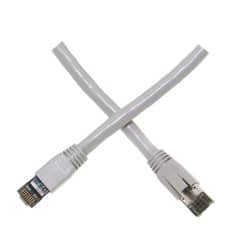 This 50-foot Category 8.1 cable, Class I channel, features a gray PVC jacket, braided outer shield, with four individually mylar foil shielded 24 AWG pure copper pairs as defined in ISO/IEC 11801 and ratified in ANSI/TIA 568-C.2-1. Cat8 cabling was designed primarily for high-speed data centers where switches, servers, and other network hardware are located in close proximity. This newest copper communications cable offers greater flexibility both literally and in distances when compared to QSFP+ and Twinax DAC assemblies which typically cost significantly more and are often much more limited in scope. It has the reach to cover Top-of-Rack and End-of-Row or Middle-of-Row network topologies while delivering 10, 25, and 40 Gigabit data rates over BASE-T technology with RJ45 ends making it a drop-in replacement for Cat6a where rates beyond 10Gb will be needed today or in the future. Cat8 has stricter specifications for noise restriction and crosstalk than any of its predecessors. The individual conductors are 24 AWG (American wire gauge) stranded pure copper. Cat8 patch cables are stranded to improve flexibility. Pure copper conductors provide the best signal possible. Each pair of conductors is shielded with an aluminum mylar foil to reduce, if not eliminate, crosstalk. These cables also have a braided shield, which protects from outside electromagnetic interference.Part No. 13X8-52150
This 50-foot Category 8.1 cable, Class I channel, features a gray PVC jacket, braided outer shield, with four individually mylar foil shielded 24 AWG pure copper pairs as defined in ISO/IEC 11801 and ratified in ANSI/TIA 568-C.2-1. Cat8 cabling was designed primarily for high-speed data centers where switches, servers, and other network hardware are located in close proximity. This newest copper communications cable offers greater flexibility both literally and in distances when compared to QSFP+ and Twinax DAC assemblies which typically cost significantly more and are often much more limited in scope. It has the reach to cover Top-of-Rack and End-of-Row or Middle-of-Row network topologies while delivering 10, 25, and 40 Gigabit data rates over BASE-T technology with RJ45 ends making it a drop-in replacement for Cat6a where rates beyond 10Gb will be needed today or in the future. Cat8 has stricter specifications for noise restriction and crosstalk than any of its predecessors. The individual conductors are 24 AWG (American wire gauge) stranded pure copper. Cat8 patch cables are stranded to improve flexibility. Pure copper conductors provide the best signal possible. Each pair of conductors is shielded with an aluminum mylar foil to reduce, if not eliminate, crosstalk. These cables also have a braided shield, which protects from outside electromagnetic interference.Part No. 13X8-52150 -
 This 25-foot Category 8.1 cable, Class I channel, features a gray PVC jacket, braided outer shield, with four individually mylar foil shielded 24 AWG pure copper pairs as defined in ISO/IEC 11801 and ratified in ANSI/TIA 568-C.2-1. Cat8 cabling was designed primarily for high-speed data centers where switches, servers, and other network hardware are located in close proximity. This newest copper communications cable offers greater flexibility both literally and in distances when compared to QSFP+ and Twinax DAC assemblies which typically cost significantly more and are often much more limited in scope. It has the reach to cover Top-of-Rack and End-of-Row or Middle-of-Row network topologies while delivering 10, 25, and 40 Gigabit data rates over BASE-T technology with RJ45 ends making it a drop-in replacement for Cat6a where rates beyond 10Gb will be needed today or in the future. Cat8 has stricter specifications for noise restriction and crosstalk than any of its predecessors. The individual conductors are 24 AWG (American wire gauge) stranded pure copper. Cat8 patch cables are stranded to improve flexibility. Pure copper conductors provide the best signal possible. Each pair of conductors is shielded with an aluminum mylar foil to reduce, if not eliminate, crosstalk. These cables also have a braided shield, which protects from outside electromagnetic interference.Part No. 13X8-52125
This 25-foot Category 8.1 cable, Class I channel, features a gray PVC jacket, braided outer shield, with four individually mylar foil shielded 24 AWG pure copper pairs as defined in ISO/IEC 11801 and ratified in ANSI/TIA 568-C.2-1. Cat8 cabling was designed primarily for high-speed data centers where switches, servers, and other network hardware are located in close proximity. This newest copper communications cable offers greater flexibility both literally and in distances when compared to QSFP+ and Twinax DAC assemblies which typically cost significantly more and are often much more limited in scope. It has the reach to cover Top-of-Rack and End-of-Row or Middle-of-Row network topologies while delivering 10, 25, and 40 Gigabit data rates over BASE-T technology with RJ45 ends making it a drop-in replacement for Cat6a where rates beyond 10Gb will be needed today or in the future. Cat8 has stricter specifications for noise restriction and crosstalk than any of its predecessors. The individual conductors are 24 AWG (American wire gauge) stranded pure copper. Cat8 patch cables are stranded to improve flexibility. Pure copper conductors provide the best signal possible. Each pair of conductors is shielded with an aluminum mylar foil to reduce, if not eliminate, crosstalk. These cables also have a braided shield, which protects from outside electromagnetic interference.Part No. 13X8-52125 -
 This 10-foot Category 8.1 cable, Class I channel, features a gray PVC jacket, braided outer shield, with four individually mylar foil shielded 24 AWG pure copper pairs as defined in ISO/IEC 11801 and ratified in ANSI/TIA 568-C.2-1. Cat8 cabling was designed primarily for high-speed data centers where switches, servers, and other network hardware are located in close proximity. This newest copper communications cable offers greater flexibility both literally and in distances when compared to QSFP+ and Twinax DAC assemblies which typically cost significantly more and are often much more limited in scope. It has the reach to cover Top-of-Rack and End-of-Row or Middle-of-Row network topologies while delivering 10, 25, and 40 Gigabit data rates over BASE-T technology with RJ45 ends making it a drop-in replacement for Cat6a where rates beyond 10Gb will be needed today or in the future. Cat8 has stricter specifications for noise restriction and crosstalk than any of its predecessors. The individual conductors are 24 AWG (American wire gauge) stranded pure copper. Cat8 patch cables are stranded to improve flexibility. Pure copper conductors provide the best signal possible. Each pair of conductors is shielded with an aluminum mylar foil to reduce, if not eliminate, crosstalk. These cables also have a braided shield, which protects from outside electromagnetic interference.Part No. 13X8-52110
This 10-foot Category 8.1 cable, Class I channel, features a gray PVC jacket, braided outer shield, with four individually mylar foil shielded 24 AWG pure copper pairs as defined in ISO/IEC 11801 and ratified in ANSI/TIA 568-C.2-1. Cat8 cabling was designed primarily for high-speed data centers where switches, servers, and other network hardware are located in close proximity. This newest copper communications cable offers greater flexibility both literally and in distances when compared to QSFP+ and Twinax DAC assemblies which typically cost significantly more and are often much more limited in scope. It has the reach to cover Top-of-Rack and End-of-Row or Middle-of-Row network topologies while delivering 10, 25, and 40 Gigabit data rates over BASE-T technology with RJ45 ends making it a drop-in replacement for Cat6a where rates beyond 10Gb will be needed today or in the future. Cat8 has stricter specifications for noise restriction and crosstalk than any of its predecessors. The individual conductors are 24 AWG (American wire gauge) stranded pure copper. Cat8 patch cables are stranded to improve flexibility. Pure copper conductors provide the best signal possible. Each pair of conductors is shielded with an aluminum mylar foil to reduce, if not eliminate, crosstalk. These cables also have a braided shield, which protects from outside electromagnetic interference.Part No. 13X8-52110 -
 This 3-foot Category 8.1 cable, Class I channel, features a gray PVC jacket, braided outer shield, with four individually mylar foil shielded 24 AWG pure copper pairs as defined in ISO/IEC 11801 and ratified in ANSI/TIA 568-C.2-1. Cat8 cabling was designed primarily for high-speed data centers where switches, servers, and other network hardware are located in close proximity. This newest copper communications cable offers greater flexibility both literally and in distances when compared to QSFP+ and Twinax DAC assemblies which typically cost significantly more and are often much more limited in scope. It has the reach to cover Top-of-Rack and End-of-Row or Middle-of-Row network topologies while delivering 10, 25, and 40 Gigabit data rates over BASE-T technology with RJ45 ends making it a drop-in replacement for Cat6a where rates beyond 10Gb will be needed today or in the future. Cat8 has stricter specifications for noise restriction and crosstalk than any of its predecessors. The individual conductors are 24 AWG (American wire gauge) stranded pure copper. Cat8 patch cables are stranded to improve flexibility. Pure copper conductors provide the best signal possible. Each pair of conductors is shielded with an aluminum mylar foil to reduce, if not eliminate, crosstalk. These cables also have a braided shield, which protects from outside electromagnetic interference.Part No. 13X8-52103
This 3-foot Category 8.1 cable, Class I channel, features a gray PVC jacket, braided outer shield, with four individually mylar foil shielded 24 AWG pure copper pairs as defined in ISO/IEC 11801 and ratified in ANSI/TIA 568-C.2-1. Cat8 cabling was designed primarily for high-speed data centers where switches, servers, and other network hardware are located in close proximity. This newest copper communications cable offers greater flexibility both literally and in distances when compared to QSFP+ and Twinax DAC assemblies which typically cost significantly more and are often much more limited in scope. It has the reach to cover Top-of-Rack and End-of-Row or Middle-of-Row network topologies while delivering 10, 25, and 40 Gigabit data rates over BASE-T technology with RJ45 ends making it a drop-in replacement for Cat6a where rates beyond 10Gb will be needed today or in the future. Cat8 has stricter specifications for noise restriction and crosstalk than any of its predecessors. The individual conductors are 24 AWG (American wire gauge) stranded pure copper. Cat8 patch cables are stranded to improve flexibility. Pure copper conductors provide the best signal possible. Each pair of conductors is shielded with an aluminum mylar foil to reduce, if not eliminate, crosstalk. These cables also have a braided shield, which protects from outside electromagnetic interference.Part No. 13X8-52103 -
 This 2-foot Category 8.1 cable, Class I channel, features a gray PVC jacket, braided outer shield, with four individually mylar foil shielded 24 AWG pure copper pairs as defined in ISO/IEC 11801 and ratified in ANSI/TIA 568-C.2-1. Cat8 cabling was designed primarily for high-speed data centers where switches, servers, and other network hardware are located in close proximity. This newest copper communications cable offers greater flexibility both literally and in distances when compared to QSFP+ and Twinax DAC assemblies which typically cost significantly more and are often much more limited in scope. It has the reach to cover Top-of-Rack and End-of-Row or Middle-of-Row network topologies while delivering 10, 25, and 40 Gigabit data rates over BASE-T technology with RJ45 ends making it a drop-in replacement for Cat6a where rates beyond 10Gb will be needed today or in the future. Cat8 has stricter specifications for noise restriction and crosstalk than any of its predecessors. The individual conductors are 24 AWG (American wire gauge) stranded pure copper. Cat8 patch cables are stranded to improve flexibility. Pure copper conductors provide the best signal possible. Each pair of conductors is shielded with an aluminum mylar foil to reduce, if not eliminate, crosstalk. These cables also have a braided shield, which protects from outside electromagnetic interference.Part No. 13X8-52102
This 2-foot Category 8.1 cable, Class I channel, features a gray PVC jacket, braided outer shield, with four individually mylar foil shielded 24 AWG pure copper pairs as defined in ISO/IEC 11801 and ratified in ANSI/TIA 568-C.2-1. Cat8 cabling was designed primarily for high-speed data centers where switches, servers, and other network hardware are located in close proximity. This newest copper communications cable offers greater flexibility both literally and in distances when compared to QSFP+ and Twinax DAC assemblies which typically cost significantly more and are often much more limited in scope. It has the reach to cover Top-of-Rack and End-of-Row or Middle-of-Row network topologies while delivering 10, 25, and 40 Gigabit data rates over BASE-T technology with RJ45 ends making it a drop-in replacement for Cat6a where rates beyond 10Gb will be needed today or in the future. Cat8 has stricter specifications for noise restriction and crosstalk than any of its predecessors. The individual conductors are 24 AWG (American wire gauge) stranded pure copper. Cat8 patch cables are stranded to improve flexibility. Pure copper conductors provide the best signal possible. Each pair of conductors is shielded with an aluminum mylar foil to reduce, if not eliminate, crosstalk. These cables also have a braided shield, which protects from outside electromagnetic interference.Part No. 13X8-52102 -
 This 1-foot Category 8.1 cable, Class I channel, features a gray PVC jacket, braided outer shield, with four individually mylar foil shielded 24 AWG pure copper pairs as defined in ISO/IEC 11801 and ratified in ANSI/TIA 568-C.2-1. Cat8 cabling was designed primarily for high-speed data centers where switches, servers, and other network hardware are located in close proximity. This newest copper communications cable offers greater flexibility both literally and in distances when compared to QSFP+ and Twinax DAC assemblies which typically cost significantly more and are often much more limited in scope. It has the reach to cover Top-of-Rack and End-of-Row or Middle-of-Row network topologies while delivering 10, 25, and 40 Gigabit data rates over BASE-T technology with RJ45 ends making it a drop-in replacement for Cat6a where rates beyond 10Gb will be needed today or in the future. Cat8 has stricter specifications for noise restriction and crosstalk than any of its predecessors. The individual conductors are 24 AWG (American wire gauge) stranded pure copper. Cat8 patch cables are stranded to improve flexibility. Pure copper conductors provide the best signal possible. Each pair of conductors is shielded with an aluminum mylar foil to reduce, if not eliminate, crosstalk. These cables also have a braided shield, which protects from outside electromagnetic interference.Part No. 13X8-52101
This 1-foot Category 8.1 cable, Class I channel, features a gray PVC jacket, braided outer shield, with four individually mylar foil shielded 24 AWG pure copper pairs as defined in ISO/IEC 11801 and ratified in ANSI/TIA 568-C.2-1. Cat8 cabling was designed primarily for high-speed data centers where switches, servers, and other network hardware are located in close proximity. This newest copper communications cable offers greater flexibility both literally and in distances when compared to QSFP+ and Twinax DAC assemblies which typically cost significantly more and are often much more limited in scope. It has the reach to cover Top-of-Rack and End-of-Row or Middle-of-Row network topologies while delivering 10, 25, and 40 Gigabit data rates over BASE-T technology with RJ45 ends making it a drop-in replacement for Cat6a where rates beyond 10Gb will be needed today or in the future. Cat8 has stricter specifications for noise restriction and crosstalk than any of its predecessors. The individual conductors are 24 AWG (American wire gauge) stranded pure copper. Cat8 patch cables are stranded to improve flexibility. Pure copper conductors provide the best signal possible. Each pair of conductors is shielded with an aluminum mylar foil to reduce, if not eliminate, crosstalk. These cables also have a braided shield, which protects from outside electromagnetic interference.Part No. 13X8-52101 -
 This 6-inch Category 8.1 cable, Class I channel, features a gray PVC jacket, braided outer shield, with four individually mylar foil shielded 24 AWG pure copper pairs as defined in ISO/IEC 11801 and ratified in ANSI/TIA 568-C.2-1. Cat8 cabling was designed primarily for high-speed data centers where switches, servers, and other network hardware are located in close proximity. This newest copper communications cable offers greater flexibility both literally and in distances when compared to QSFP+ and Twinax DAC assemblies which typically cost significantly more and are often much more limited in scope. It has the reach to cover Top-of-Rack and End-of-Row or Middle-of-Row network topologies while delivering 10, 25, and 40 Gigabit data rates over BASE-T technology with RJ45 ends making it a drop-in replacement for Cat6a where rates beyond 10Gb will be needed today or in the future. Cat8 has stricter specifications for noise restriction and crosstalk than any of its predecessors. The individual conductors are 24 AWG (American wire gauge) stranded pure copper. Cat8 patch cables are stranded to improve flexibility. Pure copper conductors provide the best signal possible. Each pair of conductors is shielded with an aluminum mylar foil to reduce, if not eliminate, crosstalk. These cables also have a braided shield, which protects from outside electromagnetic interference.Part No. 13X8-52100.5
This 6-inch Category 8.1 cable, Class I channel, features a gray PVC jacket, braided outer shield, with four individually mylar foil shielded 24 AWG pure copper pairs as defined in ISO/IEC 11801 and ratified in ANSI/TIA 568-C.2-1. Cat8 cabling was designed primarily for high-speed data centers where switches, servers, and other network hardware are located in close proximity. This newest copper communications cable offers greater flexibility both literally and in distances when compared to QSFP+ and Twinax DAC assemblies which typically cost significantly more and are often much more limited in scope. It has the reach to cover Top-of-Rack and End-of-Row or Middle-of-Row network topologies while delivering 10, 25, and 40 Gigabit data rates over BASE-T technology with RJ45 ends making it a drop-in replacement for Cat6a where rates beyond 10Gb will be needed today or in the future. Cat8 has stricter specifications for noise restriction and crosstalk than any of its predecessors. The individual conductors are 24 AWG (American wire gauge) stranded pure copper. Cat8 patch cables are stranded to improve flexibility. Pure copper conductors provide the best signal possible. Each pair of conductors is shielded with an aluminum mylar foil to reduce, if not eliminate, crosstalk. These cables also have a braided shield, which protects from outside electromagnetic interference.Part No. 13X8-52100.5 -
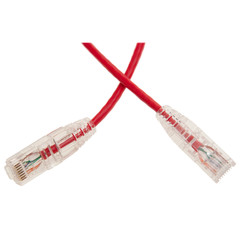 This 15ft Cat6a Red Slim Ethernet Patch Cable comes with a Snagless/Molded Boot and is the perfect solution to all of your Cat6a needs. The smaller diameter makes for a slimmer, more flexible cable that will fit well into cluttered data centers and other places where space is tight. With speeds up to 500 MHz, this cable twice as fast as regular Cat6. Our Cat6a patch cables are tested for compliance with all EIA/TIA-568-C Category 6a specifications.Part No. 13X6-67115
This 15ft Cat6a Red Slim Ethernet Patch Cable comes with a Snagless/Molded Boot and is the perfect solution to all of your Cat6a needs. The smaller diameter makes for a slimmer, more flexible cable that will fit well into cluttered data centers and other places where space is tight. With speeds up to 500 MHz, this cable twice as fast as regular Cat6. Our Cat6a patch cables are tested for compliance with all EIA/TIA-568-C Category 6a specifications.Part No. 13X6-67115 -
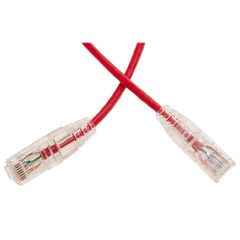 This 10ft Cat6a Red Slim Ethernet Patch Cable comes with a Snagless/Molded Boot and is the perfect solution to all of your Cat6a needs. The smaller diameter makes for a slimmer, more flexible cable that will fit well into cluttered data centers and other places where space is tight. With speeds up to 500 MHz, this cable twice as fast as regular Cat6. Our Cat6a patch cables are tested for compliance with all EIA/TIA-568-C Category 6a specifications.Part No. 13X6-67110
This 10ft Cat6a Red Slim Ethernet Patch Cable comes with a Snagless/Molded Boot and is the perfect solution to all of your Cat6a needs. The smaller diameter makes for a slimmer, more flexible cable that will fit well into cluttered data centers and other places where space is tight. With speeds up to 500 MHz, this cable twice as fast as regular Cat6. Our Cat6a patch cables are tested for compliance with all EIA/TIA-568-C Category 6a specifications.Part No. 13X6-67110 -
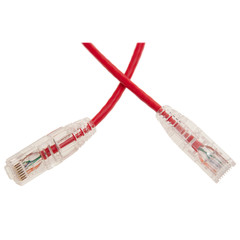 This 7ft Cat6a Red Slim Ethernet Patch Cable comes with a Snagless/Molded Boot and is the perfect solution to all of your Cat6a needs. The smaller diameter makes for a slimmer, more flexible cable that will fit well into cluttered data centers and other places where space is tight. With speeds up to 500 MHz, this cable twice as fast as regular Cat6. Our Cat6a patch cables are tested for compliance with all EIA/TIA-568-C Category 6a specifications.Part No. 13X6-67107
This 7ft Cat6a Red Slim Ethernet Patch Cable comes with a Snagless/Molded Boot and is the perfect solution to all of your Cat6a needs. The smaller diameter makes for a slimmer, more flexible cable that will fit well into cluttered data centers and other places where space is tight. With speeds up to 500 MHz, this cable twice as fast as regular Cat6. Our Cat6a patch cables are tested for compliance with all EIA/TIA-568-C Category 6a specifications.Part No. 13X6-67107 -
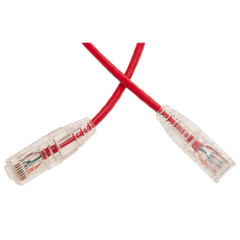 This 5ft Cat6a Red Slim Ethernet Patch Cable comes with a Snagless/Molded Boot and is the perfect solution to all of your Cat6a needs. The smaller diameter makes for a slimmer, more flexible cable that will fit well into cluttered data centers and other places where space is tight. With speeds up to 500 MHz, this cable twice as fast as regular Cat6. Our Cat6a patch cables are tested for compliance with all EIA/TIA-568-C Category 6a specifications.Part No. 13X6-67105
This 5ft Cat6a Red Slim Ethernet Patch Cable comes with a Snagless/Molded Boot and is the perfect solution to all of your Cat6a needs. The smaller diameter makes for a slimmer, more flexible cable that will fit well into cluttered data centers and other places where space is tight. With speeds up to 500 MHz, this cable twice as fast as regular Cat6. Our Cat6a patch cables are tested for compliance with all EIA/TIA-568-C Category 6a specifications.Part No. 13X6-67105 -
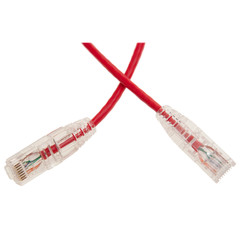 This 3ft Cat6a Red Slim Ethernet Patch Cable comes with a Snagless/Molded Boot and is the perfect solution to all of your Cat6a needs. The smaller diameter makes for a slimmer, more flexible cable that will fit well into cluttered data centers and other places where space is tight. With speeds up to 500 MHz, this cable twice as fast as regular Cat6. Our Cat6a patch cables are tested for compliance with all EIA/TIA-568-C Category 6a specifications.Part No. 13X6-67103
This 3ft Cat6a Red Slim Ethernet Patch Cable comes with a Snagless/Molded Boot and is the perfect solution to all of your Cat6a needs. The smaller diameter makes for a slimmer, more flexible cable that will fit well into cluttered data centers and other places where space is tight. With speeds up to 500 MHz, this cable twice as fast as regular Cat6. Our Cat6a patch cables are tested for compliance with all EIA/TIA-568-C Category 6a specifications.Part No. 13X6-67103 -
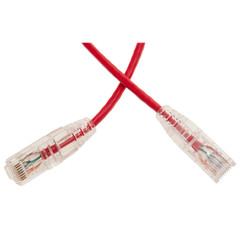 This 1ft Cat6a Red Slim Ethernet Patch Cable comes with a Snagless/Molded Boot and is the perfect solution to all of your Cat6a needs. The smaller diameter makes for a slimmer, more flexible cable that will fit well into cluttered data centers and other places where space is tight. With speeds up to 500 MHz, this cable twice as fast as regular Cat6. Our Cat6a patch cables are tested for compliance with all EIA/TIA-568-C Category 6a specifications.Part No. 13X6-67101
This 1ft Cat6a Red Slim Ethernet Patch Cable comes with a Snagless/Molded Boot and is the perfect solution to all of your Cat6a needs. The smaller diameter makes for a slimmer, more flexible cable that will fit well into cluttered data centers and other places where space is tight. With speeds up to 500 MHz, this cable twice as fast as regular Cat6. Our Cat6a patch cables are tested for compliance with all EIA/TIA-568-C Category 6a specifications.Part No. 13X6-67101 -
 This 6 Inch Cat6a Red Slim Ethernet Patch Cable comes with a Snagless/Molded Boot and is the perfect solution to all of your Cat6a needs. The smaller diameter makes for a slimmer, more flexible cable that will fit well into cluttered data centers and other places where space is tight. With speeds up to 500 MHz, this cable twice as fast as regular Cat6. Our Cat6a patch cables are tested for compliance with all EIA/TIA-568-C Category 6a specifications.Part No. 13X6-67100.5
This 6 Inch Cat6a Red Slim Ethernet Patch Cable comes with a Snagless/Molded Boot and is the perfect solution to all of your Cat6a needs. The smaller diameter makes for a slimmer, more flexible cable that will fit well into cluttered data centers and other places where space is tight. With speeds up to 500 MHz, this cable twice as fast as regular Cat6. Our Cat6a patch cables are tested for compliance with all EIA/TIA-568-C Category 6a specifications.Part No. 13X6-67100.5



